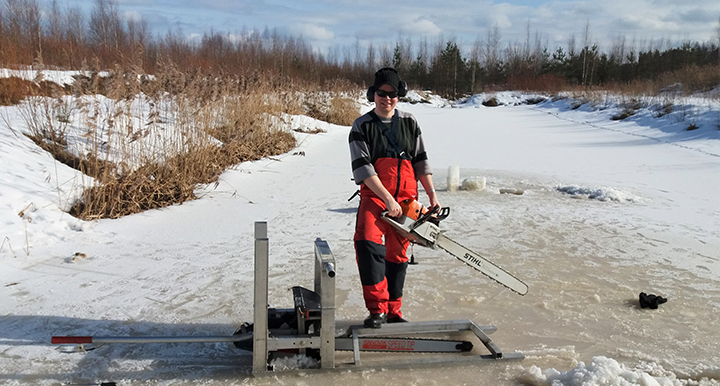New natural freezing method offers energy savings in water purification
Freezing winter temperatures can be put to good use in improving the cost and energy efficiency of wastewater purification. The ice that is formed when wastewater freezes naturally in the winter is cleaner than the residual waste water itself. The purity of the ice is a function of the rate of the freezing process: the slower the freezing process, the greater the purity of the resulting ice. Research is underway under the Academy of Finland’s Arctic Research Programme to develop sustainable working methods that are suited to the unique and fragile Arctic environment.
Associate professor of Chemical Engineering Marjatta Louhi-Kultanen is running a research project aimed at developing energy-efficient methods of wastewater purification by taking advantage of seasonal temperature variations and natural water freezing. The process of freezing wastewater requires no additional energy input in the winter. The ice layer is mechanically removed from the residual wastewater, which then becomes more concentrated. Energy is only required for breaking and transporting the frozen wastewater. Contaminants in the ice samples collected in both laboratory conditions and natural winter conditions were well below environmental permit standards. Contaminant levels in ice samples extracted from mine water reservoirs were up to 65–90 per cent lower than in the mine water itself. The results indicate that natural freezing is a particularly effective method for purifying large volumes of weak aqueous solutions.

Otto-Ville Sormunen taking an ice sample at a treatment facility for peat bog water at Konnunsuo. Photo: Mikko Suominen, Aalto University
“Although the mine ice was clearly purer than the mine water, its measured mechanical strength values were clearly lower than those of clean lake water. The mechanical collection of ice from mines would therefore not require expensive special equipment,” says Dr Mikko Suominen from the Aalto University research team studying marine and Arctic technology.
The research project has also used a winter simulator that makes it possible to adjust and fine-tune the freezing process by controlling aqueous solutions and the temperature and velocity of cooling air. It is important to have an in-depth knowledge of the strength and other mechanical properties of ice so that the process of ice collection can be optimised. The results of the research have important application in developing systems for breaking and collecting ice.
The project is a joint effort of teams from Lappeenranta University of Technology and Aalto University. Their key areas of focus include freezing kinetics, mathematical modelling and the development of mechanical processes, such as breaking, analysing, collecting and transporting ice. Furthermore, they have applied the tested purification method to both landfill waters and municipal wastewater. Tests have also been carried out on mine water reservoirs in Sotkamo, in two peat bog areas and on the ice on Lake Saimaa.
On 6–7 June 2018 the Academy of Finland will be hosting an international conference on the topical theme of “Emerging Pollutants in Freshwater Ecosystems” as part of the European Water JPI network. The Helsinki conference will be attended by more than 200 researchers, decision-makers and partners in the field. During the two days of the conference, keynote lectures and presentations will be held among others on the hazardous pollutants threatening our drinking water and on how chemicals and pesticides, for instance, enter the water cycle. The effects of pollutants on the ecosystem and human health as well as new methods for monitoring and preventing pollutants are also included in the programme.
More information and inquiries
- Water JPI 2018 Conference
- Arctic Academy Programme (ARKTIKO) 2014-2020
- Marjatta Louhi-Kultanen, Aalto University, firstname.lastname(at)aalto.fi, tel. +358 50 324 5780